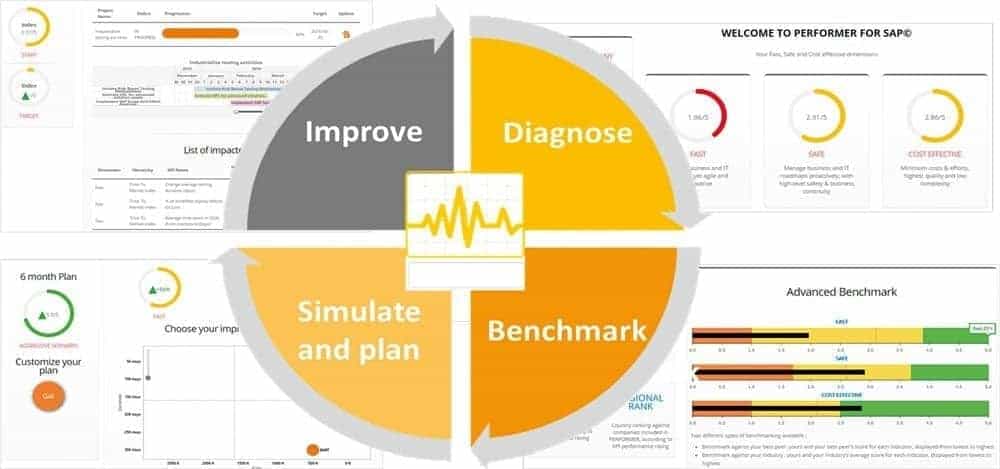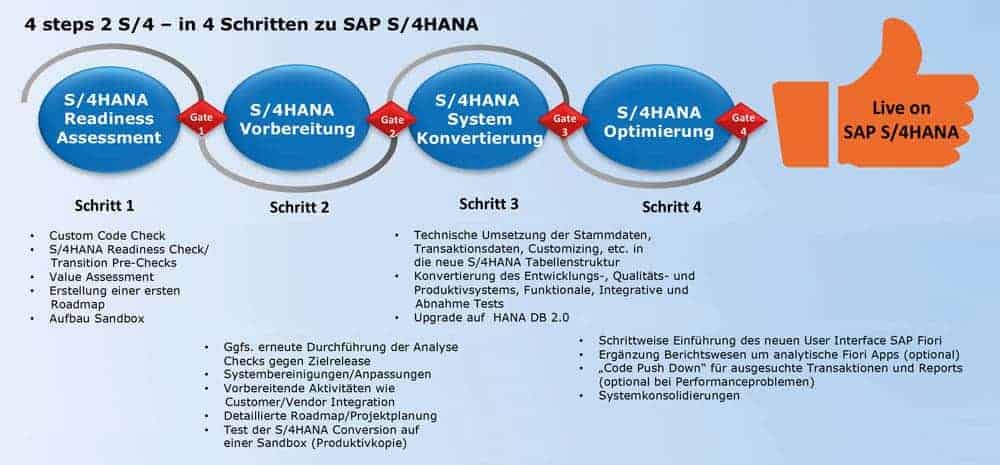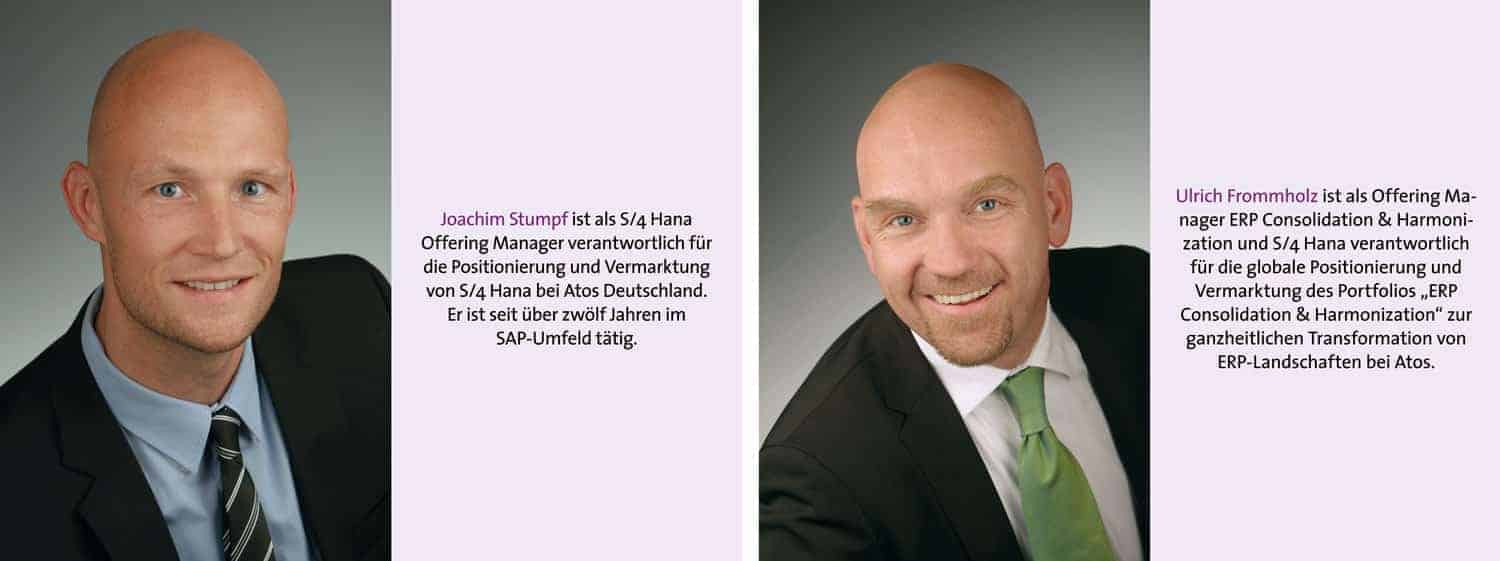Fit for S/4 Hana?


While at the beginning it was mainly small and medium-sized companies that made the switch to S/4 Hana, there is now hardly an SAP customer who is not considering a move to the new innovation platform.
At the beginning of this new ERP era, new implementations, i.e. companies that took S/4 Hana as an opportunity to set up their ERP landscape from scratch, still accounted for around 3/4 of the total market.
In the meantime, this ratio has reversed. Kim Mathaess (SAP) explained at this year's DSAG that approximately 75 percent of all S/4 Hana projects are now system conversions.
The reason for this change is certainly, on the one hand, the improved availability of information and tools on the subject of conversion and the accompanying increase in customer confidence in this transition scenario.
And secondly, the fact that larger companies in particular have initially approached the subject in the context of proof of concepts or roadmaps, while actual project implementations are now only gradually getting underway.
For large corporations in particular, the changeover requires particularly careful preparation, planning and development of a transition roadmap due to the often very complex system landscapes with historically grown structures.
Hardly any company is really aware of the complexity of its own developments and modifications. It is even more unacceptable for a customer to have to deal in detail with the 894-page Simplification List, let alone assess the implications for customer developments and programs.
The S/4 Hana conversion thus initially represents a black box in which the effort involved and the expected timeline can hardly be estimated. So how do we shed light on the darkness?
Four steps to S/4 Hana
No large budget is required for an initial preliminary analysis. As part of the "4 Steps 2 S/4 Hana" approach, Atos offers its customers an S/4 Hana Readiness Assessment as a first step to better estimate the effort drivers that have a significant influence on the duration and expected complexity of the S/4 Hana migration and to become aware of possible showstoppers at an early stage.
The heart of the assessment is the Custom Code Check, a list of the customer's own objects that need to be adapted under S/4 Hana due to the simplified data model.
In addition, there is the S/4 Hana Readiness or Simplification Item Check, which is delivered in the form of SAP notes and identifies those simplification items that are relevant for the respective customer system.
In addition, a check is made to determine the extent to which existing business functions, industry solutions and add-ons are still compatible with the desired S/4 Hana target release.
We recommend that customers considering a changeover carry out these analyses at an early stage. This is because many adjustments, such as the cleansing of data inconsistencies, can already be initiated by customers in their ECC system today.
In general, the more carefully a conversion is planned and prepared, the smoother the changeover can be. It is by no means advisable to simply make unchecked program adjustments, but rather to first always critically question whether applications are still being used at all.
The results of the checks should therefore be compared with the Usage Procedure Protocol, for example, in order to adapt only those programs that are actually used.
The Atos S/4 Hana Conversion Factory in India can support in evaluating the result lists from the above analyses and create an effort estimate for the required adjustments. Only then is it possible and sensible to define a more detailed S/4 Hana Conversion Roadmap.
Particularly for large corporations where complex system landscapes with a large number of ERP systems have to be converted, manual adaptation of the coding is not a viable solution. Here, Atos works with its partner SmartShift, which makes it possible to automate a large part of the adjustments and thus save time and costs.

Hana Value Assessment
The Atos service portfolio of the Readiness Assessment is flanked by an S/4 Hana Value Assessment, in which Atos analyzes the individual added value of a switch from S/4 together with its customer. Here, the strategic partnership with Inventy and its analysis tool "Performer for SAP" is of particular importance.
The big data platform Performer for SAP uses almost 1000 performance indicators to identify optimization potential and automatically calculates the business benefits. In addition, comparisons with other companies are made via a benchmark in order to derive optimization strategies.
The value assessment approach is accompanied by S/4 Hana demo and showcase workshops at Atos Business Technology & Innovation Centers (BTIC) or at customer sites. The showcases take place on Atos' own demo system, which is based on the latest S/4 Hana release and uses content in line with SAP Activate Best Practice.
They play a key role in helping customers understand the benefits of S/4 Hana, including the innovative SAP Fiori user interface. The scenarios go beyond pure S/4 Hana functionality and also include, for example, integration with a geographic information system (GIS) or IoT applications.
Implementation planning
If the customer decides to switch to S/4 Hana as part of a system conversion, this must be planned in detail in the subsequent preparation phase.
The more cleanup of the source system is done, the fewer potential sources of error there will be in the course of the conversion. Here, for example, it is advisable to use the Solution Manager's Decommissioning Cockpit to dispose of unused coding in advance.
Since several months often pass between the initial analyses and the actual implementation phase, it is advisable to subsequently repeat the checks against the actual S/4 Hana target release of the project.
Warnings vs. error messages
The Simplification Item Check differentiates between warnings and actual error messages. The warnings also include notices that in fact do not require any intervention, for example, if certain business functions are automatically activated with the S/4 migration, such as the activation of Self Service Procurement.
If negative interactions with other functionalities can be ruled out, nothing further needs to be done here. The error messages, on the other hand, require more intensive attention.
All S/4 customers are affected by the conversion to the business partner known from Customer Relation Management. This must be implemented in the ECC system in advance of the conversion. Depending on the complexity, this can take several weeks or even several months and must therefore be taken into account in the project planning.
If the new general ledger is not yet in use and functionalities such as document split or ledger solutions are desired after the S/4 Hana conversion, a separate New GL project should be considered in advance of the S/4 project.
A possible result of the transition pre-check can also be the non-availability of certain ECC functionalities under S/4 Hana, as is the case with preference management, for example.
In such cases, Atos uses the SAP product roadmap to check when corresponding successor products will be available. If the customer cannot do without the functionality even in the meantime, alternative solutions must be elicited or, in the worst case, such messages can become a showstopper for the project.
In most cases, however, only a fraction of the simplification items actually apply to the specific customer system. In previous Atos conversion projects, the range was between 15 and about 50 relevant message types.
To gain additional security, Atos recommends performing a test conversion on a copy of the production system during the preparation phase.
Upgrade to Hana 2.0
The conversion of the productive system landscape is carried out using the SUM (Software Update Manager) procedure familiar from the Enhancement Package Upgrades. If the upgrade to the Hana database takes place at the same time, the conversion is performed in combination with the Database Migration Option (DMO).
Customers who have already converted their systems to the Hana database must take into account that from a S/4 Hana target release greater than or equal to 1709, Hana version 2.0 is required and a corresponding upgrade must be planned.
The conversion of the development system to S/4 Hana then takes place on a copy, while the ECC system line remains in place to supply the production system. From this point on, parallel operation will require dual development on ECC and S/4 Hana.
In order to avoid that the productive system and the converted S/4 Hana systems diverge, it is recommended to keep this phase as short as possible. For this reason, too, Atos recommends the use of automated code adjustments.
The primary goal of an S/4 conversion is to get an existing ECC system running under S/4 Hana; in contrast to the greenfield approach, the implementation of new functionalities is not initially the focus. These can be implemented in a subsequent optimization phase, for example by successively switching to the new SAP Fiori user interface.
Conclusion
For customers considering an S/4 Hana conversion, there are hardly any more reasons not to start with preparatory steps today. Cleaning up the system of code that is no longer used or identifying potential problem areas as part of the pre-checks should be tackled promptly, completely independently of a concrete upcoming roadmap.






